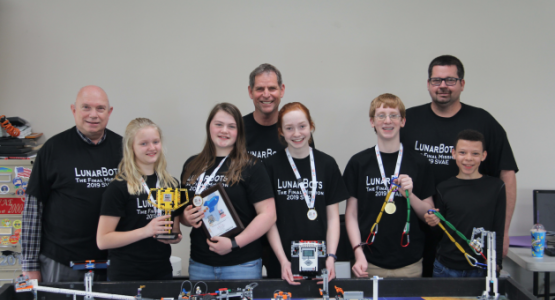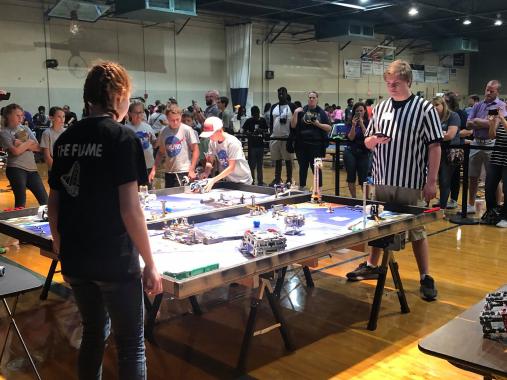
SVAE Robotics Team Wins National Tournament
Story by Tiffany Doss
Seven months of intense work and preparation culminated into 37-and-a-half minutes of careful execution, ultimately ending in victory. Students and faculty from the Shenandoah Valley Adventist Elementary (SVAE) school in New Market, Va., recently participated in their 12th annual Adventist Robotics League competition (pictured), this time bringing home the gold from the national competition held in Florida, along with the Astro Falcon team from the Linda Vista Adventist Elementary School (Calif.). The team—comprised of five eighth-graders—scored first in robot design and programming, core values/teamwork and for their project on space, the tournament’s theme.
This competition requires teams to design, build, program and operate robots to compete in a head-to-head challenge. “As coaches, we don’t do any of the programming or building,” explains Gordon Miller, SVAE’s teacher and robotics coach. “Our biggest role is to encourage students on the team, help them with goal sets and learn time management. While working together, students develop skills and practice engineering principles, while thinking innovatively and sharing ideas.”
 Miller says these critical skill sets help make a team work well collectively and accomplish what they set out to do. He also believes this is some of the best preparation for real life. “I have seen students really learn how to deal with conflict,” he adds. “These kids spend a lot of time together while working on something that can be extremely frustrating. I’ve watched teams figure out how to navigate those tough points and come out more confident and stronger on the other side. It’s hard to learn those life skills in a classroom.”
Miller says these critical skill sets help make a team work well collectively and accomplish what they set out to do. He also believes this is some of the best preparation for real life. “I have seen students really learn how to deal with conflict,” he adds. “These kids spend a lot of time together while working on something that can be extremely frustrating. I’ve watched teams figure out how to navigate those tough points and come out more confident and stronger on the other side. It’s hard to learn those life skills in a classroom.”
Each competition also includes a theme-based project. Teams hone their public speaking skills for a five-minute presentation. “The intimidation factor is real,” says Miller. “It’s real for the students in it, but it’s amazing to see their confidence grow; to hear them speak more clearly and taking on-the-spot questions without missing a beat.”
Miller believes these clubs benefit students so much that he wishes robotics would be part of the curriculum in schools. “The most intimidating part about coaching a robotics team is simply taking the idea off the back-burner and getting started,” he says. “It can seem really overwhelming at first, and it’s easy to talk yourself out of doing one, but you just have to dive in. There are so many benefits. I see real changes in my students. When we first started, we didn’t have a clue [about] how to begin or what to do—but we just got started. Today there’s so many resources online and teaching tools that anyone can learn. You can learn how to program, build a robot and download plans. This wasn’t available when we started over a decade ago. The time is now!”

Add new comment